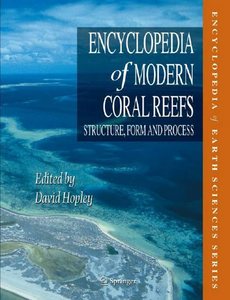Lagoons
Hopley, David (2011) Lagoons. In: Hopley, David, (ed.) Encyclopedia of Modern Coral Reefs: structure, form and process. Encyclopedia of Earth Science . Springer, Dordrecht, The Netherlands, pp. 617-618.
![[img]](https://researchonline.jcu.edu.au/19082/1.hassmallThumbnailVersion/19082_Hopley_2011_Book_Cover.jpg)
|
Image (JPEG) (Book Cover)
- Cover Image
Download (95kB) |
|
|
PDF (Published Version)
- Published Version
Restricted to Repository staff only |
Abstract
[Extract] Fully or partly enclosed depressions in coral reefs are common. They range in depth from 1 or 2 m to > 90 m with the largest occurring in atolls, e.g., Kwajalein (Marshall Islands) 120 x 32 km or Rangiroa (Tuamotu) 79 x 34 km. They have many origins including the following:
*Shallow moats behind reef flat rubble banks
*"Boat channels" a few metres deep behind a fringing reef attached to the shore
*Deeper lagoons behind reefal rims around volcanic islands as in the Darwinian sequence
*Shelf reef lagoons of probable karst inheritance (Purdy, 1974) but with some Holocene growth to the rim (see Reef Classification by Hopley (1982)). These reefs and their lagoons can be > 100 km2 in area (e.g., Hopley, 2006)
*Extensive lagoons of atolls some of which may be entirely closed off from the ocean. Purdy and Winterer (2001) have shown that only about 10 m of lagoon rim relief in these largest of lagoons (> 250 km2) is the result of reef growth, the remainder (> 20 m) is due to dissolution over several glacial/interglacial cycles and only a small amount due to subsidence
*Depressions resembling karst but originating from the rapid Acropora dominated growth (> 6 m/ka) from patch and reticulated foundations and including collapse of depression walls (Wyrwoll et al., 2006)
All types are sediment sinks and for fringing reefs terrigenous sediments may dominate the lagoon floor. In terms of hydrography, lagoons can be divided into three classes, normal, brackish, and hypersaline, which combined with circulation, can exert a major influence on the sedimentological characteristics of the lagoon (Milliman, 1974). Normal lagoons display temperatures and salinities similar to those of the adjacent ocean. In brackish lagoons, freshwater influx from run-off and rainfall exceeds evaporation: the opposite is true of hypersaline lagoons.
| Item ID: | 19082 |
|---|---|
| Item Type: | Book Chapter (Reference) |
| ISBN: | 978-90-481-2639-2 |
| Date Deposited: | 18 Jan 2012 01:29 |
| FoR Codes: | 04 EARTH SCIENCES > 0406 Physical Geography and Environmental Geoscience > 040601 Geomorphology and Regolith and Landscape Evolution @ 100% |
| SEO Codes: | 97 EXPANDING KNOWLEDGE > 970104 Expanding Knowledge in the Earth Sciences @ 100% |
| Downloads: |
Total: 315 Last 12 Months: 11 |
| More Statistics |



